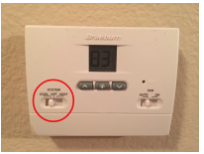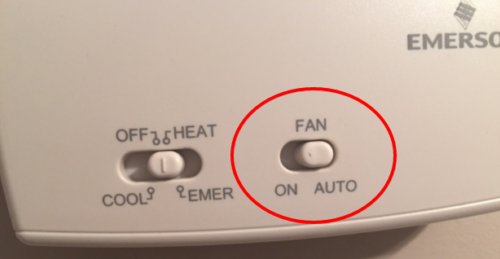Common Heat Pump Problems in Phoenix (And Their Solutions)
November 21, 2019
If you have a heat pump, you may be wondering what kind of issues you could be facing in the future with your system.
Some common heat pump problems include:
- Running constantly
- Blowing cold air in winter
- Struggling to turn on
- Making rattling noises
Below, we will look at each of these issues in more detail and give you some insight on how to fix each of these problems.
Experiencing one of the issues listed above and want to speak with a professional about it? We can help you! Our techs are highly trained to handle any heat pump repair. Learn more about the heat pump repair services we offer or...
Common Problem #1: Running constantly
A common complaint we hear from homeowners is that their heat pump is running constantly.
But, before we dive into why your heat pump is running constantly, let’s define what “running constantly” actually means.
If it’s very hot (over 100) or very cold (below 30), your heat pump will struggle to either cool or heat your home and will need to run more frequently to reach your desired temperature. While it may seem like your heat pump is running “constantly,” if your heat pump is reaching your set temperature, it's probably just a hotter or colder day than normal, which means your heat pump will have to run more to meet your temperature needs. This is normal.
However, if your heat pump is running non-stop throughout the day (and isn’t reaching your set temperature), you likely have an issue, like:
1. Your refrigerant levels are low- Refrigerant is the substance that either carries heat into your home in heating mode or out of your home in cooling mode. If your refrigerant levels are low, your heat pump won’t be able to transfer as much heat per cycle, which can cause it to run constantly. If your refrigerant levels are low, there is a leak in your refrigerant line. To fix this, you’ll need to hire an HVAC tech to repair your refrigerant lines and refill your refrigerant.
2. Your air filter is clogged- If your air filter is clogged, it will reduce the amount of air your heat pump is able to draw in, which in turn reduces the amount of conditioned air your heat pump can pump out. To fix this, check your air filter and replace it if it’s dirty.

If it looks like the filter on the right, it’s time to replace your air filter.
Common Problem #2: Blowing cold air in winter
If you notice that your heat pump is blowing cold air in winter, there are two possible explanations:
- Your heat pump is fine, you just feel like it’s cold
- You have an issue with your heat pump
Heat pumps generally produce air that’s around 90 degrees, but your body temperature is around 98 degrees, so the air that heat pumps produce can feel cold. To check whether your heat pump is actually pumping cold air into your home, check the temperature of the air near supply and return vents. If they are different temperatures, your heat pump is working just fine.
On the other hand, if the temperature of the air around your supply and return vents are the same temperature (within 1-3 degrees of each other), you likely have an issue with your heat pump, such as:
1. Low refrigerant levels- As we mentioned above, if refrigerant levels are low, your heat pump won’t be able to draw in as much heat as necessary to heat your home, which is why you may notice cooler air coming from your vents.
2. Thermostat set to COOL- Check your thermostat and ensure that it is set to HEAT, not COOL.

3. Thermostat fan set to ON- Ensure that your thermostat fan is set to AUTO, not ON. When set to ON, your heat pump will blow air regardless of whether that air has been heated or not.

4. Reversing valve issue- The reversing valve is the part of your heat pump that determines whether your system is in heating or cooling mode. If there is an issue with your reversing valve, your heat pump could be stuck in cooling mode. To fix this, contact a technician to come take a look at your system.
Common Problem #3: Won’t turn on
Typically, if your heat pump won’t turn on, there’s an issue with your thermostat.
If you recently had a new thermostat installed, it could simply be that something went wrong in the installation process.
If you haven’t had a thermostat installed recently, take a look at your thermostat settings and ensure that your thermostat is set to COOL during summer and HEAT during winter. If it’s on the wrong setting, it likely won’t turn on.
If you’re still having issues with your heat pump turning on, contact a technician. They should be able to take a look at your system and determine what the issue is.
Common Problem #4: Making rattling noises
There are a variety of reasons your heat pump could be making a rattling noise, including:
- A displaced fan blade
- Debris in the outdoor unit
- A damaged motor
- Loose panels or other loose parts
If you hear a rattling noise coming from your heat pump, you should contact a technician to come and take a look. Regardless of what the issue is, each of the situations listed above can cause long-term damage to your system if they aren’t taken care of in a timely manner.
Need professional help with your heat pump? Hire the best in the business: Patrick Riley!
Whether you’re experiencing one of the issues listed above or you’re having another issue with your heat pump, we can help. With years of experience helping Phoenix homeowners, we have the knowledge and training necessary to diagnose and repair any issue you’re facing.
Get 10% off (Up to $150)

Ty Lindsay is the Director of Field Operations at Patrick Riley | Isley’s and a 15-year veteran of the plumbing and HVAC trades. In 2010, Ty earned his Journeyman’s plumbing license. He became a Master Plumber five years later and earned his Journeyman HVAC technician’s license that same year. Ty’s breadth of knowledge in plumbing and HVAC includes both residential and commercial work. He’s been a loyal member of the Patrick Riley | Isley’s team since 2016.
- Posted in:
- Troubleshooting
